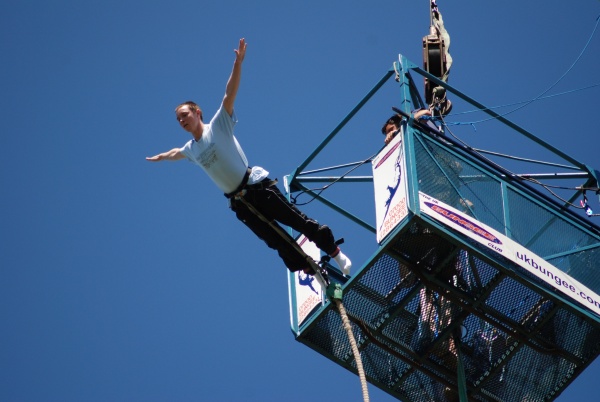Question #6e509
2 Answers
To solve this problem using the knowledge of physics we assume that
-
the bungee rope behaves as an ideal spring and Hook;s law is obeyed here.
-
jumper just steps of bridge and falls straight downward.
-
If the height of the jumper is neglected comparing with the length of the rope, the position of the jumper may be considered as a point.
-
The loss in gravitational potential energy of the jumper provides the gain in potential energy of the stretched rope at the first lowest position of the jumper, ignoring dissipation of energy during elongation of rope.
Now if the elongation of rope be
where
Again the loss PE of jumper
where
Here
So by conservation of energy
The jumper jumps from 44m above the water level of the river . If we add the length (20m) of the relaxed rope with the elongation the total elongated length becomes
At this stage the upward force on jumper due to elastic property of the rope
and downward gravitational pull
So net upward pull on the jumper
~~~~~~~~~~~~~~~~~~~~~~~~~~~~~~~~
Let at the final position when oscillation stops the net elongation be
At this stage the gravitational pull is the cause of stretching and by Hook's law we can write
Adding the length of the relaxed rope with it the lowest final position of the jumper will be
At this position the net force on the jumper will be Zero as he is at rest.
Alternate solution based on solution already posted by @dk_ch.
Explanation:
Following assumptions are made
-
The bungee rope behaves as an ideal spring and obeys Hook's law.
-
Jumper just steps off bridge and falls straight downward as shown below. The center of gravity in this position is almost at the level of platform where the jumper stands.
 -
The other end of rope is tied at the center of gravity of the jumper. The picture of jumper at the time of reaching the lowest point is as shown below. As such the effective height of platform is taken as if the thickness of jumper is neglected as compared to the length of the rope.
 )
)
The loss in gravitational potential energy of the jumper gets converted into kinetic energy of the jumper till relaxed length of rope is reached. Thereafter further loss of potential energy and kinetic energy is used to stretch the rope.
Taking downward direction as positive
Potential energy stored in the stretched rope
#PE_"rope"=1/2kx^2#
where#k# is spring constant of the rope#=160Nm^(-1)#
#x# is elongation of the rope.
Also the loss of PE of jumper at the lowest point
#PE_"jumper"=mgh#
where#m# is mass of the jumper.
#g# acceleration due to gravity#=9.81ms^-2#
#h# is maximum fall of jumper#="length of relaxed rope"+x_max#
By conservation of energy we get
Inserting given values we get
Plotting this equation using the graphic tool and taking only the positive root as length can not be negative we get
It is given that the jumper jumps from bridge
At this point only two force are acting on the jumper.
A. the upward force on jumper which can be found using Spring equation for force
#F=-kx#
#F=-160xx16.53N# ,
#-ve# sign shows that force is in the upward direction.
B. Downward force as weight
Net force on the jumper is sum of both forces

